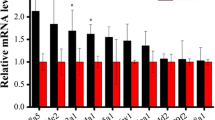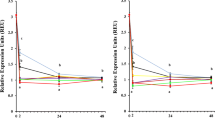Abstract
Induction of aldrin epoxidase activity by polychlorinated biphenyls (PCBs) (Arochlor 1221, 1242, and 1254) was studied with five strains of house flies which differed in their level of microsomal enzyme activity, as measured by the epoxidation of aldrin. The strains with a low basal level of aldrin epoxidase activity are inducible whereas those with a high level of epoxidase activity are not. As an inducer, Arochlor 1254 is the most effective of the three PCBs, followed by Arochlor 1242 and Arochlor 1221, in decreasing order of activity. Thus, PCBs with higher chlorine content are apparently better inducers of the enzyme. A “no-effect” level for enzyme induction by PCBs apparently does not exist because a measurable degree of induction occurrs even after exposure to extremely low doses of PCBs. Differences among house fly strains exist in the dose dependency and in the time course of enzyme induction.
Similar content being viewed by others
References
Arias, R. O., and L. C. Terriere: The hydroxylation of naphthalene −1-14C by house fly microsomes. J. Econ. Entomol.55 925 (1962).
Bagley, G. E., W. L. Reichel, and E. Cromartie: Identification of polychlorinated biphenyls in two bald eagles by combined gas — liquid chromatography — mass spectrometry. J. Ass. Offic. Anal. Chem.53 251 (1970).
Biros, F. J., A. C. Walker, and A. Milby: Polychlorinated biphenyls in human adipose tissue. Bull. Environ. Contam. Toxicol.5 317 (1970).
Bitman, J., and H. Cecil: Estrogenic activity of DDT analogs and polychlorinated biphenyls. J. Agr. Food Chem.18 1108 (1970).
Duke, T. W., J. I. Lowe, and A. J. Wilson, Jr.: A polychlorinated biphenyl (Arochlor 1254®) in the water, sediment, and biota of Escambia bay, Florida. Bull. Environ. Contam. Toxicol.5 171 (1970).
Gabliks, J., and E. Maltby-Askari: The effect of chlorinated hydrocarbons on drug metabolism in mice. In W. B. Deichmann (ed.): Pesticide symposia, pp. 27. Miami, Florida: Halos and Associates, Inc. (1970).
Gil, L., B. C. Fine, M. L. Dinamarca, I. Balazs, J. R. Busvine, and M. Agosin: Biochemical studies on insecticide resistance inMusca domestica. Entomol. Exp. Appl.11 15 (1968).
Gillett, J. W., and T. M. Chan: Cyclodiene insecticides as inducers, substrates, and inhibitors of microsomal epoxidation. J. Agr. Food Chem.16 590 (1968).
Hammond, A. L.: Chemical pollution: polychlorinated biphenyls. Science127 155 (1972).
Hansen, L. G. and E. Hodgson: Biochemical characteristics of insect microsomes:N- andO-Demethylation. Biochem. Pharmacol.20 1569 (1971a).
—— —— Metabolism of naphthalene and 1-naphthol by enzyme preparations from the housefly,Musca domestica. Pesticide Biochem. Physiol.1 464 (1971b).
Holmes, D. C., J. H. Simmons, and J. O'G. Totton: Chlorinated hydrocarbons in British wildlife. Nature216 227 (1967).
Hook, G. E. R., T. W. Jordan, and J. N. Smith: Factors affecting insect microsomal oxidations. In E. Hodgson (ed.): Enzymatic oxidations of toxicants, p. 27. Proceedings of a conference held at North Carolina State University at Raleigh, North Carolina. Raleigh: North Carolina State University (1968).
Hoyer, R. F., and F. W. Plapp, Jr.: A gross genetic analysis of two DDT-resistant house fly strains. J. Econ. Entomol.59 495 (1966).
Jensen, S.: Report of a new chemical hazard. New Scientist32 612 (1966).
——, A. G. Johnels, M. Olsson, and G. Otterlind: DDT and PCB in marine animals from Swedish waters. Nature224 247 (1969).
Koeman, J. H., M. C. Ten Noever de Brauw, and R. H. de Vos: Chlorinated biphenyls in fish, mussels and birds from the River Rhine and the Netherlands coastal area. Nature221 1126 (1969).
Oppenoorth, F. J., and N. W. H. Houx: DDT resistance in the housefly caused by microsomal degradation. Entomol. Exp. Appl.11 81 (1968).
Peakall, D. B., and J. L. Lincer: Polychlorinated biphenyls: another long — life widespread chemical in the environment. BioScience20 958 (1970).
Perry, A. S.: Studies on microsomal cytochrome P-450 in resistant and susceptible house flies. Life Sci.9 335 (1970).
Plapp, F. W., Jr., and J. E. Casida: Genetic control of house fly NADPH — dependent oxidases: relation to insecticide chemical metabolism and resistance. J. Econ. Entomol.62 1174 (1969).
—— —— Induction by DDT and dieldrin of insecticide metabolism by housefly enzymes. J. Econ. Entomol.63 1091 (1970).
Reynolds, L. M.: Pesticide residue analysis in the presence of PCBs. Presented at the 4th annual Western Canada seminar on pesticide residue analysis, Winnipeg, June (1969).
Risebrough, R. W., P. Rieche, S. G. Herman, D. B. Peakall, and M. N. Kirven: Polychlorinated biphenyls in the global eco — system. Nature220 1098 (1968).
Schonbrod, R. D., W. W. Philleo, and L. C. Terriere: Hydroxylation as a factor in resistance in house flies. J. Econ. Entomol.58 74 (1965).
——, and L. C. Terrriere: Eye pigments as inhibitors of microsomal aldrin epoxidase in the house fly. J. Econ. Entomol.64 44 (1971a).
—— —— Inhibition of housefly microsomal epoxidase by eye pigment, xanthommatin. Pesticide Biochem. Physiol.1 409 (1971b).
Tsukamoto, M., and J. E. Casida: Metabolism of methylcarbamate insecticides by the NADPH2 requiring enzyme system from housefly. Nature213 49, (1967).
Walker, C. R., and L. C. Terriere: Induction of microsomal oxidases by dieldrin inMusca domestica. Entomol. Exp. Appl.13 260 (1970).
Yu, S. J., and L. C. Terriere: Induction of microsomal oxidases in the house fly and the action of inhibitors and stress factors. Pesticide Biochem. Physiol.1 173 (1971a).
—— —— Hormonal modification of microsomal oxidase activity in the housefly. Life Sci.10 1173 (1971b).
Author information
Authors and Affiliations
Rights and permissions
About this article
Cite this article
Rhee, K.S., Plapp, F.W. Polychlorinated biphenyls (PCBs) as inducers of microsomal enzyme activity in the house fly. Arch. Environ. Contam. Toxicol. 1, 182–192 (1973). https://doi.org/10.1007/BF01986007
Received:
Accepted:
Issue Date:
DOI: https://doi.org/10.1007/BF01986007




